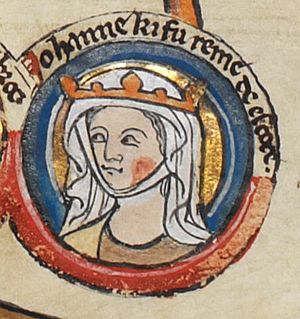Joan of England, Queen of Scotland facts for kids
Quick facts for kids Joan of England |
|
|---|---|
 |
|
| Queen consort of Scotland | |
| Tenure | 21 June 1221 – 4 March 1238 |
| Born | 22 July 1210 |
| Died | 4 March 1238 (aged 27) Havering-atte-Bower, England |
| Burial | Tarrant Abbey, Dorset |
| Spouse | |
| House | Plantagenet |
| Father | John, King of England |
| Mother | Isabella of Angoulême |
Joan of England (born 1210, died 1238) was a queen. She became the Queen consort of Scotland in 1221 and held this title until her death. She was the third child of King John of England and Isabella of Angoulême.
Contents
Joan's Early Life and Marriage Plans
Joan was born on July 22, 1210. When she was young, the King of France, Philip II, wanted her to marry his son.
However, in 1214, Joan's father, King John, made a different promise. He said Joan would marry Hugh X of Lusignan. This was a way to make up for Hugh's earlier broken engagement to Joan's mother, Isabella.
Joan was promised land as a dowry. A dowry was like a gift of money or property given by the bride's family to the groom. She was sent to live with Hugh X's family to be raised there until the marriage.
Becoming Queen of Scotland
After King John of England died in 1216, Joan's mother, Isabella, decided to marry Hugh X herself. Hugh X tried to keep Joan with him. He hoped to gain her dowry and also get her mother's dowry from England.
In 1220, after the Pope got involved, Joan was sent back to England. Talks began for her to marry Alexander II of Scotland. Alexander had met Joan's father before. It was said that King John had promised Joan to Alexander as his bride.
On June 18, 1221, Alexander officially set aside lands for Joan. These lands would provide her with her own income. Joan and Alexander were married on June 21, 1221, at York Minster. Alexander was 23 years old, and Joan was almost 11.
Life as Queen and Later Years
Joan and Alexander did not have any children. This was a worry because it meant there was no direct heir to the Scottish throne. However, ending their marriage was seen as too risky. It could have caused a war with England, Joan's home country.
Queen Joan did not have a very strong position in the Scottish court. Alexander's mother, Queen Ermengarde, was still very powerful. But Joan's family connections to England made her important.
In 1236 and 1237, Joan traveled with Alexander to England. They met with her brother, King Henry III of England. They discussed land disputes between England and Scotland.
During this time, some people believed Joan and Alexander had grown apart. Joan wanted to spend more time in England. Her brother, King Henry, gave her homes in England where she could stay if she wished.
Joan died on March 4, 1238, at the age of 27. She passed away in the arms of her brothers, King Henry and Richard of Cornwall. She was buried at Tarrant Crawford Abbey in Dorset, England, as she had wished.
Joan's Legacy
King Henry III continued to remember Joan fondly for the rest of his life. In 1252, almost 14 years after her death, Henry ordered a special marble statue for Joan's tomb. This statue was one of the first of its kind for a queen in England.
Today, nothing remains of the church where Joan was buried. It is said that she is now buried in a golden coffin in the graveyard.
See also
 In Spanish: Juana de Inglaterra, reina de Escocia para niños
In Spanish: Juana de Inglaterra, reina de Escocia para niños

